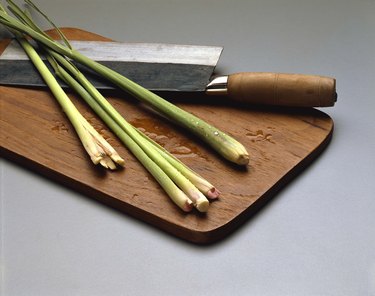
Lemongrass (Cymbopogon citratus) foliage gives off a lemony aroma and has a light citrus flavor, making the grass stalks a tasty addition to your favorite recipe. This perennial grass grows in U.S. Department of Agriculture plant hardiness zones 10 and 11, although you can overwinter it in pots indoors in any climate. Cutting back the plants at the right time, for appearance or harvest, ensures they remain both attractive and productive.
Harvest
Video of the Day
Lemongrass tolerates frequent cutting for harvesting, although plants won't grow as tall or full if you harvest often. You can cut back the stalks in summer as soon as they develop to a 1/2-inch thickness, or you can harvest once yearly in fall. A sharp, clean knife, disinfected in a solution of 1 part bleach to 9 parts water, cuts through the mature stalks without damaging the plant. Remove the stalks at the base. Cutting out the oldest and largest stalks first leaves the younger stalks to continue growing, so the plant doesn't look bare or sparse.
Video of the Day
Winter Pruning
The plants send up feathery seed heads in fall, providing texture to the winter garden. In spring, the plants often look bedraggled because of their dead and winter-damaged leaves. You can cut back the entire plant to a 6-inch height, removing all the old seed heads and dead foliage in the process, in late winter or early spring just before growth resumes. Alternatively, cut out only the damaged leaves and old seed stalks, removing them at their base, if the plant didn't suffer severe damage or dieback.
Maintenance Pruning
The symmetrical mounded shape of a lemongrass plant doesn't require pruning to maintain, but you may need to cut out dead and damaged stalks throughout the growing season. You can remove these at anytime without damaging the plant. When pruning out damaged stalks, select those that are obviously brown and dead, overly tattered or showing symptoms of fungal problems such as leaf spotting. Disinfect your knife after each cut, especially if fungus is present, so you don't spread diseases to the surrounding healthy foliage.
Division
Division thins out your lemongrass plants and provides you with more plants for the garden. Fall is the best time to divide -- before the first expected frost but after the last harvest. Dig up the roots and break them apart into 6-inch sections. The sections must contain both roots and shoots to grow into a new plant. Plant each lemongrass division into a pot filled with standard potting soil or in a well-drained area of the garden bed, setting the roots at the same depth they were growing at previously.